-
Paper Information
- Next Paper
- Previous Paper
- Paper Submission
-
Journal Information
- About This Journal
- Editorial Board
- Current Issue
- Archive
- Author Guidelines
- Contact Us
American Journal of Computational and Applied Mathematics
p-ISSN: 2165-8935 e-ISSN: 2165-8943
2013; 3(3): 162-167
doi:10.5923/j.ajcam.20130303.02
(1,2) - Domination in Line Graphs of Cn, Pn and K1,n
N. Murugesan, Deepa. S. Nair
Post Graduate and Research Department of Mathematics, Government Arts College, Coimbatore-18, India
Correspondence to: Deepa. S. Nair, Post Graduate and Research Department of Mathematics, Government Arts College, Coimbatore-18, India.
| Email: |  |
Copyright © 2012 Scientific & Academic Publishing. All Rights Reserved.
In this paper we discuss the (1,2) - domination in line graphs of Cn, Pn and K1,n .(1,2)-domination number of paths, cycles, star graphs are found and compared it with the usual domination number. Also we find the domination number of line graphs of these graphs.
Keywords: Dominating Set, Domination Number, (1,2) - dominating Set, (1,2) - domination Number
Cite this paper: N. Murugesan, Deepa. S. Nair, (1,2) - Domination in Line Graphs of Cn, Pn and K1,n, American Journal of Computational and Applied Mathematics , Vol. 3 No. 3, 2013, pp. 162-167. doi: 10.5923/j.ajcam.20130303.02.
Article Outline
1. Introduction
- Let G = (V,E) be a simple graph. A subset D of V is a dominating set of G if every vertex of V- D is adjacent to a vertex of D. The domination number of G, denoted by γ(G), is the minimum cardinality of a dominating set of G.[1,2]A (1,2) - dominating set in a graph G = (V,E) is a set S having the property that for every vertex v in V - S there is atleast one vertex in S at distance 1 from v and a second vertex in S at distance almost 2 from v. The order of the smallest (1,2) - dominating set of G is called the (1,2) - domination number of G and we denote it by γ(1,2).[7]The line graph L(G) of a graph G = (V,E) is a graph with vertex set E(G) in which two vertices are adjacent if and only if the corresponding edges in G are adjacent.[8]
2. (1,2) - domination in Paths
- Throughout this paper Pn denotes a path on n vertices, Cn denotes a cycle with n vertices and K1,n is a star graph. Consider the following paths
 {2,3} is a (1,2) - dominating set.γ(1,2) = 2
{2,3} is a (1,2) - dominating set.γ(1,2) = 2  {2,3} is a (1,2) - dominating set.γ(1,2) = 2
{2,3} is a (1,2) - dominating set.γ(1,2) = 2  {2,3,4 } is a (1,2) - dominating set.γ(1,2) = 3
{2,3,4 } is a (1,2) - dominating set.γ(1,2) = 3 {2,3,4,5} is a (1,2) - dominating set.γ(1,2) = 4
{2,3,4,5} is a (1,2) - dominating set.γ(1,2) = 4 {2,3,4,5,6} is a (1,2) - dominating set.γ(1,2) = 5
{2,3,4,5,6} is a (1,2) - dominating set.γ(1,2) = 5 {2,3,4,5,6,7} is a (1,2) - dominating set.γ(1,2) = 6
{2,3,4,5,6,7} is a (1,2) - dominating set.γ(1,2) = 6  {2,3,4,5,6,7,8} is a (1,2) - dominating set.γ(1,2) = 7
{2,3,4,5,6,7,8} is a (1,2) - dominating set.γ(1,2) = 7  {2,3,4,5,6,7,8,9} is a (1,2) - dominating set.γ(1,2) = 8From the above examples we have the following theorem.Theorem 2.1(1,2) - domination number of a path graph Pn, for n ≥ 4 is n-2.Proof:Let Pn be a path with n vertices v1, v2, ...,vn. Then v2, v3, ...,vn-1 are of degree 2 ,v1 and v2 are of degree 1. That is n-2 vertices are of degree 2. Each vertex v1 is adjacent to vi+1. Therefore, vi's are at distance one from vi+1. Each vertex vi+2 is at distance 2 from vi. So to form a (1,2) - dominating set we have to include all those vertices of degree 2. But there are n-2 vertices of degree 2. Hence γ(1,2) = n-2.The following lemma is due to Gray Chartrand and Ping Zhang.[3]Lemma 1. γ( Pn) =
{2,3,4,5,6,7,8,9} is a (1,2) - dominating set.γ(1,2) = 8From the above examples we have the following theorem.Theorem 2.1(1,2) - domination number of a path graph Pn, for n ≥ 4 is n-2.Proof:Let Pn be a path with n vertices v1, v2, ...,vn. Then v2, v3, ...,vn-1 are of degree 2 ,v1 and v2 are of degree 1. That is n-2 vertices are of degree 2. Each vertex v1 is adjacent to vi+1. Therefore, vi's are at distance one from vi+1. Each vertex vi+2 is at distance 2 from vi. So to form a (1,2) - dominating set we have to include all those vertices of degree 2. But there are n-2 vertices of degree 2. Hence γ(1,2) = n-2.The following lemma is due to Gray Chartrand and Ping Zhang.[3]Lemma 1. γ( Pn) =  The following theorem gives the relationship between domination number and (1,2)-domination number.Theorem 2.2The domination number of the path Pn is less than (1,2) domination number.Proof:We have γ(Pn) =
The following theorem gives the relationship between domination number and (1,2)-domination number.Theorem 2.2The domination number of the path Pn is less than (1,2) domination number.Proof:We have γ(Pn) =  In a graph G, domination number is less than or equals (1,2) domination number[6]. Let G be a graph and D be its dominating set. Then every vertex in V-D is adjacent to a vertex in D. That is, in D, for every vertex u, there is a vertex which is at distance 1 from u. But it is not necessary that there is a second vertex at distance atmost 2 from u. So if we find a (1,2)- dominating set, it will contain more vertices or atleast equal number of vertices than the dominating set. So the domination number is less than or equal to (1,2)-domination number.In particular, for paths domination number is less than(1,2) domination number. Hence the theorem.
In a graph G, domination number is less than or equals (1,2) domination number[6]. Let G be a graph and D be its dominating set. Then every vertex in V-D is adjacent to a vertex in D. That is, in D, for every vertex u, there is a vertex which is at distance 1 from u. But it is not necessary that there is a second vertex at distance atmost 2 from u. So if we find a (1,2)- dominating set, it will contain more vertices or atleast equal number of vertices than the dominating set. So the domination number is less than or equal to (1,2)-domination number.In particular, for paths domination number is less than(1,2) domination number. Hence the theorem.3. (1,2)-domination in Cycles
- Consider the following cycles
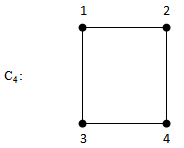 {2,3} is a (1,2) - dominating set.γ(1,2) = 2
{2,3} is a (1,2) - dominating set.γ(1,2) = 2 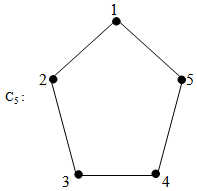 {1,3,4} is a (1,2) - dominating set.γ(1,2) = 3
{1,3,4} is a (1,2) - dominating set.γ(1,2) = 3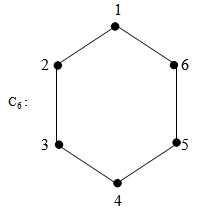 {1,2,4} is a (1,2) - dominating set. γ(1,2) = 3
{1,2,4} is a (1,2) - dominating set. γ(1,2) = 3 {1,3,4,7} is a (1,2) - dominating set.γ(1,2) = 4From the above examples we have the following theorem.Theorem 3.1
{1,3,4,7} is a (1,2) - dominating set.γ(1,2) = 4From the above examples we have the following theorem.Theorem 3.1 Proof:Every cycle Cn have n vertices and n edges in which each vertex is of degree 2. That is each vertex dominates two vertices . Case 1: n is even. Let v1, v2, ...,vn be the vertices of Cn. v1 and vn are adjacent. Also v1 is adjacent to v2, v2 is adjacent to v3 and so on. Each vi, 1 < i < n is not adjacent to vi+2, vi+3, vi+4,..., vn-1. Let us construct a (1,2) - dominating set. If we take the vertex v1,v1 is adjacent to v2 and vn and non-adjacent to all other n-2 vertices. v3 and vn-1 are at distance 2 from v1. So we have to take v2 and any one of v3, vn-1 in the set. If we take v2, v2 is adjacent to v1 and v3 and non- adjacent to v4, v5, ... vn. That is n-3 vertices and v4 and vn-2 are at distance 2 from v2. Similarly we can proceed upto all the n vertices. Finally we get a (1,2)- dominating set containing v1, v2, v4, v6,.., vn-2. The cardinality of this set is 1+
Proof:Every cycle Cn have n vertices and n edges in which each vertex is of degree 2. That is each vertex dominates two vertices . Case 1: n is even. Let v1, v2, ...,vn be the vertices of Cn. v1 and vn are adjacent. Also v1 is adjacent to v2, v2 is adjacent to v3 and so on. Each vi, 1 < i < n is not adjacent to vi+2, vi+3, vi+4,..., vn-1. Let us construct a (1,2) - dominating set. If we take the vertex v1,v1 is adjacent to v2 and vn and non-adjacent to all other n-2 vertices. v3 and vn-1 are at distance 2 from v1. So we have to take v2 and any one of v3, vn-1 in the set. If we take v2, v2 is adjacent to v1 and v3 and non- adjacent to v4, v5, ... vn. That is n-3 vertices and v4 and vn-2 are at distance 2 from v2. Similarly we can proceed upto all the n vertices. Finally we get a (1,2)- dominating set containing v1, v2, v4, v6,.., vn-2. The cardinality of this set is 1+ -1, that is
-1, that is  . Hence γ(1,2) =
. Hence γ(1,2) =  , if n is even Case 2: n is oddIf n is odd, we remove one vertex v1, then the other n-1 vertices form a path Pn-1 and n-1 is even. But (1,2) - domination number of Pn-1 is n- 3. These n-3 vertices and the vertex v1 from a (1,2) dominating set. Hence the cardinality of the (1,2) dominating set is n- 3+1. that is n-2. Hence γ(1,2) = n-2, if n is odd.
, if n is even Case 2: n is oddIf n is odd, we remove one vertex v1, then the other n-1 vertices form a path Pn-1 and n-1 is even. But (1,2) - domination number of Pn-1 is n- 3. These n-3 vertices and the vertex v1 from a (1,2) dominating set. Hence the cardinality of the (1,2) dominating set is n- 3+1. that is n-2. Hence γ(1,2) = n-2, if n is odd.4. (1,2)-domination in Star Graphs
- Consider the following star graphs.
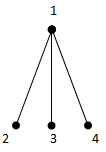 {1,2} form a (1,2) - dominating set.γ(1,2) = 2
{1,2} form a (1,2) - dominating set.γ(1,2) = 2 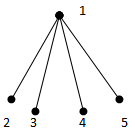 {1,2} form a (1,2) - dominating set.γ(1,2) = 2
{1,2} form a (1,2) - dominating set.γ(1,2) = 2 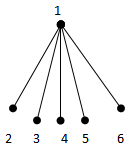 {1,2} form a (1,2) - dominating set. γ(1,2) = 2
{1,2} form a (1,2) - dominating set. γ(1,2) = 2 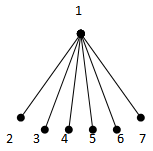 {1,2} form a (1,2) - dominating set. γ(1,2) = 2 Theorem 4.1For any star K1,n, γ(1,2)(K1,n) = 2.Proof:In a star K1,n, there are n+1 vertices v, v1, v2, ...,vn. v is adjacent to all other vertices v1, v2, ...,vn. {v1, v2, ...,vn} form an independent set. Each of v1, v2, ...,vn are at a distance 1 from v and each of v2 , v3,...,vn are at a distance 2 from v1.So we can form a (1,2) dominating set as {v, v1}. Clearly the cardinality is two. Hence γ(1,2)(K1,n) = 2.
{1,2} form a (1,2) - dominating set. γ(1,2) = 2 Theorem 4.1For any star K1,n, γ(1,2)(K1,n) = 2.Proof:In a star K1,n, there are n+1 vertices v, v1, v2, ...,vn. v is adjacent to all other vertices v1, v2, ...,vn. {v1, v2, ...,vn} form an independent set. Each of v1, v2, ...,vn are at a distance 1 from v and each of v2 , v3,...,vn are at a distance 2 from v1.So we can form a (1,2) dominating set as {v, v1}. Clearly the cardinality is two. Hence γ(1,2)(K1,n) = 2.5. (1,2) - domination in the Line Graph of Pn, Cn, K1,n.
- In this section first we discuss the line graphs of paths, cycles and star graphs.Consider the paths and the corresponding line graphs
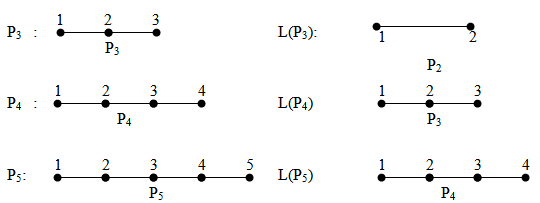 Next consider the cycles and the corresponding line graphs
Next consider the cycles and the corresponding line graphs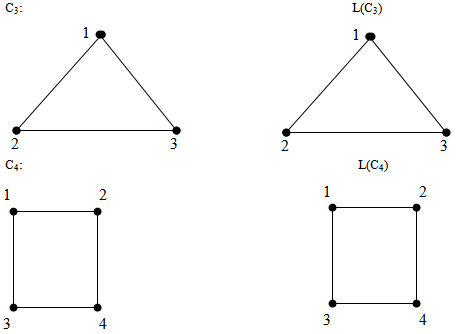 Consider the following star graphs and the corresponding line graphs
Consider the following star graphs and the corresponding line graphs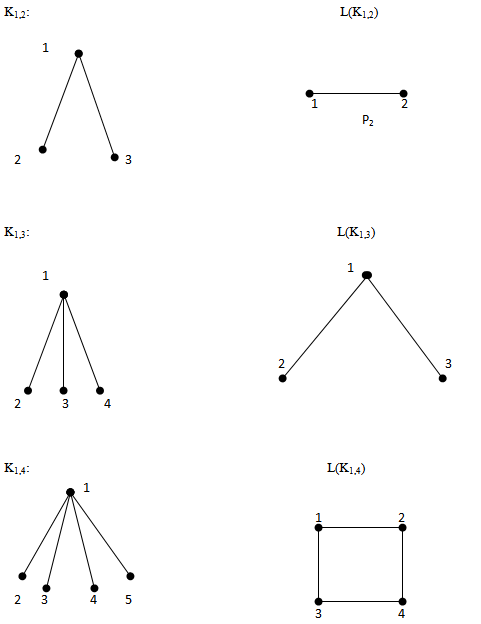 From the above examples and from[7] we have the following observationsThe line graph of Pn, L(Pn) has (i) n-1 vertices and n-2 edges(ii) 2 vertices of degree 1 and n-3 vertices of degree 2.Hence L(Pn) = Pn-1. The line graph of Cn has(i) n vertices and n edges(ii) Each vertex is of degree 2(iii) The graph is cyclicHence L(Cn)= Cn.The line graph of K1,n has(i) n-1 edges and n vertices(ii) Each of the n vertices is of degree 2.(iii) The graph is cyclicL(K1,n) = Cn for n ≥ 3.Theorem 5.1(1,2) - domination number of L(Pn) is n-3. Proof :Pn has n vertices and n-1 edges and L(Pn) is Pn-1 with n-1 vertices and n-2 edges. Then by theorem 2.1, (1,2) - domination number of Pn-1 with n-3. Hence (1,2) - domination in the line graph of L(Pn) is n-3.Theorem 5.2
From the above examples and from[7] we have the following observationsThe line graph of Pn, L(Pn) has (i) n-1 vertices and n-2 edges(ii) 2 vertices of degree 1 and n-3 vertices of degree 2.Hence L(Pn) = Pn-1. The line graph of Cn has(i) n vertices and n edges(ii) Each vertex is of degree 2(iii) The graph is cyclicHence L(Cn)= Cn.The line graph of K1,n has(i) n-1 edges and n vertices(ii) Each of the n vertices is of degree 2.(iii) The graph is cyclicL(K1,n) = Cn for n ≥ 3.Theorem 5.1(1,2) - domination number of L(Pn) is n-3. Proof :Pn has n vertices and n-1 edges and L(Pn) is Pn-1 with n-1 vertices and n-2 edges. Then by theorem 2.1, (1,2) - domination number of Pn-1 with n-3. Hence (1,2) - domination in the line graph of L(Pn) is n-3.Theorem 5.2 Proof:The line graph of Cn, L(Cn) is Cn itself. So we can apply theorem 3.1
Proof:The line graph of Cn, L(Cn) is Cn itself. So we can apply theorem 3.1 Theorem 5.3(1,2) - domination number of L(K1,n) is same as that of Cn.Proof:The line graph of K1,n is Cn. Then by theorem 3.2,
Theorem 5.3(1,2) - domination number of L(K1,n) is same as that of Cn.Proof:The line graph of K1,n is Cn. Then by theorem 3.2,
6. Conclusions
- In this paper the (1,2)-dominating sets and (1.2) - domination numbers of some standard graphs Pn, Cn and K1,nhave been discussed and the results extended to the line graphs of those graphs. It is also found that (1,2) - domination number of Cn and K1,n are same.
 Abstract
Abstract Reference
Reference Full-Text PDF
Full-Text PDF Full-text HTML
Full-text HTML